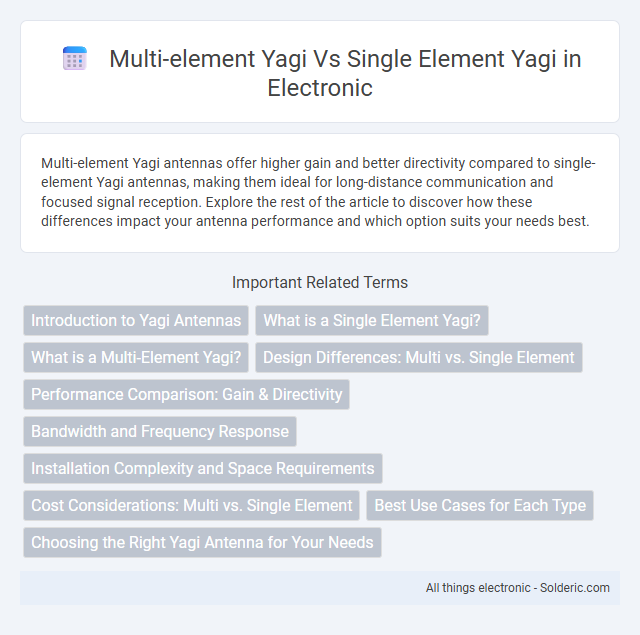Multi-element Yagi antennas offer higher gain and better directivity compared to single-element Yagi antennas, making them ideal for long-distance communication and focused signal reception. Explore the rest of the article to discover how these differences impact your antenna performance and which option suits your needs best.
Comparison Table
| Feature | Multi-Element Yagi | Single Element Yagi |
|---|---|---|
| Design | Multiple elements (reflector, driven, directors) | Single driven element only |
| Gain | High gain, typically 7-15 dBi | Low gain, around 2-3 dBi |
| Directivity | Highly directional | Omnidirectional or slight directivity |
| Bandwidth | Moderate bandwidth | Wide bandwidth |
| Size | Larger and longer | Compact and shorter |
| Applications | Long-range communication, TV reception, amateur radio | Basic TV antennas, short-range communication |
| Complexity | More complex to build and tune | Simple and easy to construct |
Introduction to Yagi Antennas
Multi-element Yagi antennas feature multiple driven and parasitic elements, significantly enhancing gain, directivity, and signal strength compared to single element Yagi antennas, which have only one driven element. You can achieve better reception and transmission performance with multi-element designs, especially in long-range communication applications. These antennas are widely used for television reception, amateur radio, and wireless networking due to their improved ability to focus signals and reduce interference.
What is a Single Element Yagi?
A Single Element Yagi consists of one driven element, typically a dipole, used to transmit or receive radio waves with directional focus. Unlike multi-element Yagis, it lacks additional parasitic elements such as reflectors or directors, limiting its gain and directivity. This simpler design results in a broader radiation pattern but lower efficiency in signal amplification compared to multi-element configurations.
What is a Multi-Element Yagi?
A multi-element Yagi antenna consists of multiple parasitic elements, such as directors and reflectors, arranged along a boom to enhance gain and directivity compared to a single-element Yagi. This configuration improves signal reception and transmission by focusing radio waves more effectively in a specific direction. The increased number of elements results in higher gain, narrower beamwidth, and better front-to-back ratio, making multi-element Yagis ideal for long-distance communication.
Design Differences: Multi vs. Single Element
Multi-element Yagi antennas incorporate several directors and reflectors along with the driven element, enhancing gain and directivity compared to single element Yagis that only have one driven element without additional parasitic elements. The presence of multiple elements in a multi-element Yagi improves signal focus and bandwidth, optimizing performance for long-distance communications. In contrast, single element Yagis offer simpler construction and lower cost but exhibit reduced forward gain and less precise beam shaping.
Performance Comparison: Gain & Directivity
Multi-element Yagi antennas deliver significantly higher gain and improved directivity compared to single-element Yagi designs, concentrating signal strength more effectively in a specific direction. The additional driven and parasitic elements enhance the antenna's ability to reject interference and increase front-to-back ratio, optimizing your signal reception and transmission. Single-element Yagis provide simpler setups with lower gain, making multi-element versions preferable for applications requiring stronger, more focused performance.
Bandwidth and Frequency Response
Multi-element Yagi antennas provide enhanced bandwidth and improved frequency response compared to single-element Yagi designs, thanks to their additional directors and reflectors that optimize signal reception across a wider frequency range. These elements create multiple resonances, reducing signal loss and ensuring more stable performance over varied frequencies. Your choice of antenna will greatly impact communication quality, especially in applications requiring flexible frequency handling.
Installation Complexity and Space Requirements
Multi-element Yagi antennas require more precise alignment and additional mounting hardware compared to single-element Yagis, increasing installation complexity. The spatial footprint of multi-element designs is significantly larger due to multiple driven and parasitic elements, necessitating more installation space. Single-element Yagis are simpler to install and ideal for limited space environments, while multi-element versions demand careful planning and ample room for optimal performance.
Cost Considerations: Multi vs. Single Element
Multi-element Yagi antennas typically incur higher production and material costs due to additional elements like directors and reflectors, which require precise spacing and quality construction. Single-element Yagi antennas offer a more budget-friendly option with simplified design and easier manufacturing, reducing overall expenses. However, the increased gain and directivity of multi-element designs often justify the higher investment for applications demanding enhanced signal performance.
Best Use Cases for Each Type
Multi-element Yagi antennas provide higher gain and better directivity, making them ideal for long-distance communications, such as amateur radio, television reception, and point-to-point wireless links. Single-element Yagi antennas, being simpler and more compact, are better suited for portable applications, short-range communications, and urban environments where space is limited. Choosing between these types depends on requirements like gain, range, antenna size, and operating environment.
Choosing the Right Yagi Antenna for Your Needs
Selecting a multi-element Yagi antenna provides greater gain and directivity compared to a single-element Yagi, making it ideal for long-distance communication and reducing interference from unwanted signals. Single-element Yagis are simpler, more compact, and easier to install, suitable for basic applications where size and ease of use are priorities. Evaluating factors such as communication range, installation space, and signal clarity helps determine the optimal Yagi antenna configuration for your specific needs.
multi-element yagi vs single element yagi Infographic

 solderic.com
solderic.com